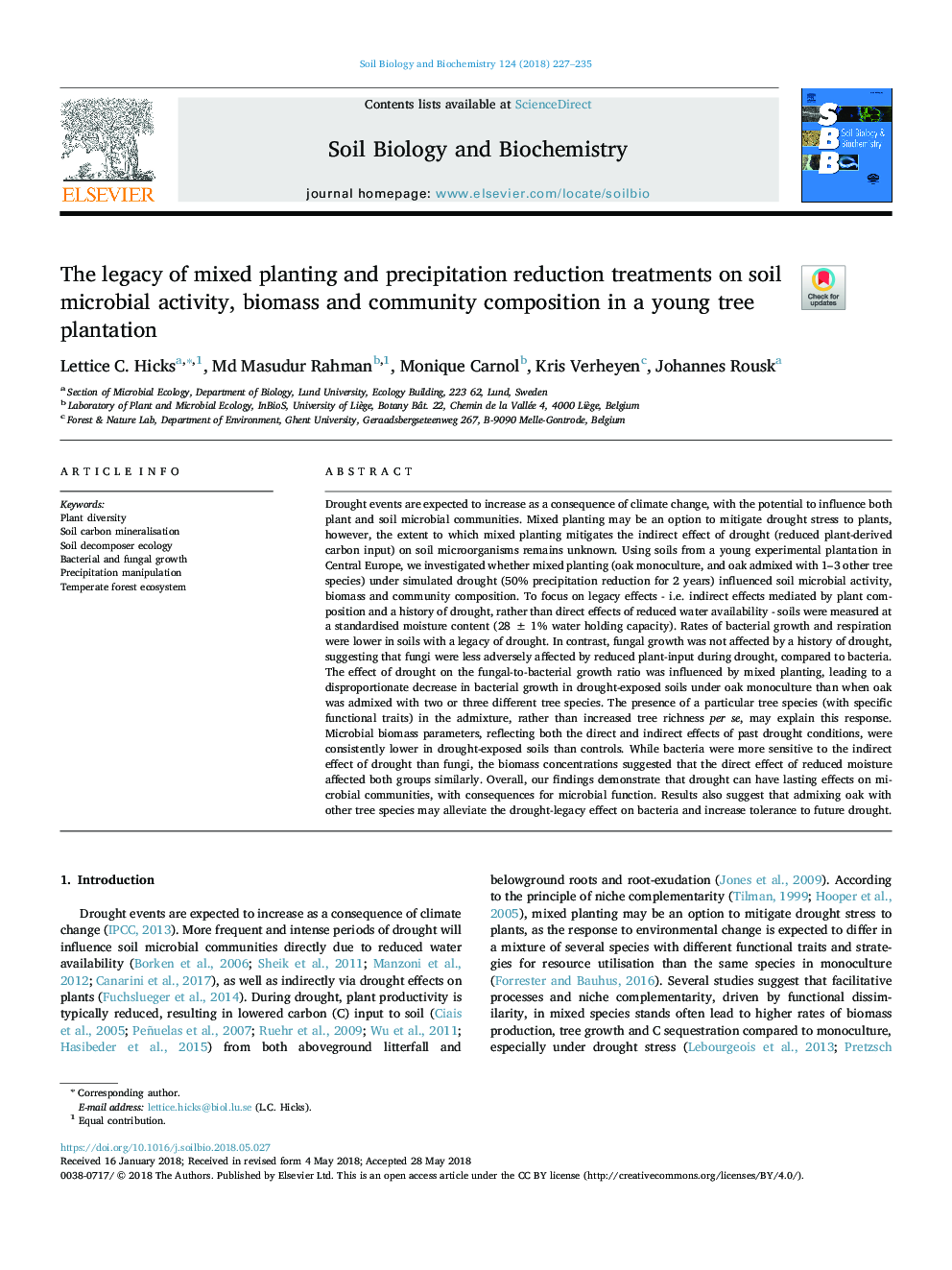| کد مقاله | کد نشریه | سال انتشار | مقاله انگلیسی | نسخه تمام متن |
|---|---|---|---|---|
| 8362604 | 1542560 | 2018 | 9 صفحه PDF | دانلود رایگان |
عنوان انگلیسی مقاله ISI
The legacy of mixed planting and precipitation reduction treatments on soil microbial activity, biomass and community composition in a young tree plantation
ترجمه فارسی عنوان
میراث گیاه مخلوط کاشت و کاهش بارندگی در فعالیت های میکروبی خاک، زیست توده و ترکیب جامعه در کاشت درختان جوان
دانلود مقاله + سفارش ترجمه
دانلود مقاله ISI انگلیسی
رایگان برای ایرانیان
کلمات کلیدی
تنوع گیاهی، کانی سازی کربن خاک، بوم شناسی تجزیه کننده خاک، رشد باکتری و قارچی، دستکاری بارش، اکوسیستم جنگل مرطوب
موضوعات مرتبط
علوم زیستی و بیوفناوری
علوم کشاورزی و بیولوژیک
دانش خاک شناسی
چکیده انگلیسی
Drought events are expected to increase as a consequence of climate change, with the potential to influence both plant and soil microbial communities. Mixed planting may be an option to mitigate drought stress to plants, however, the extent to which mixed planting mitigates the indirect effect of drought (reduced plant-derived carbon input) on soil microorganisms remains unknown. Using soils from a young experimental plantation in Central Europe, we investigated whether mixed planting (oak monoculture, and oak admixed with 1-3 other tree species) under simulated drought (50% precipitation reduction for 2 years) influenced soil microbial activity, biomass and community composition. To focus on legacy effects - i.e. indirect effects mediated by plant composition and a history of drought, rather than direct effects of reduced water availability - soils were measured at a standardised moisture content (28â¯Â±â¯1% water holding capacity). Rates of bacterial growth and respiration were lower in soils with a legacy of drought. In contrast, fungal growth was not affected by a history of drought, suggesting that fungi were less adversely affected by reduced plant-input during drought, compared to bacteria. The effect of drought on the fungal-to-bacterial growth ratio was influenced by mixed planting, leading to a disproportionate decrease in bacterial growth in drought-exposed soils under oak monoculture than when oak was admixed with two or three different tree species. The presence of a particular tree species (with specific functional traits) in the admixture, rather than increased tree richness per se, may explain this response. Microbial biomass parameters, reflecting both the direct and indirect effects of past drought conditions, were consistently lower in drought-exposed soils than controls. While bacteria were more sensitive to the indirect effect of drought than fungi, the biomass concentrations suggested that the direct effect of reduced moisture affected both groups similarly. Overall, our findings demonstrate that drought can have lasting effects on microbial communities, with consequences for microbial function. Results also suggest that admixing oak with other tree species may alleviate the drought-legacy effect on bacteria and increase tolerance to future drought.
ناشر
Database: Elsevier - ScienceDirect (ساینس دایرکت)
Journal: Soil Biology and Biochemistry - Volume 124, September 2018, Pages 227-235
Journal: Soil Biology and Biochemistry - Volume 124, September 2018, Pages 227-235
نویسندگان
Lettice C. Hicks, Md Masudur Rahman, Monique Carnol, Kris Verheyen, Johannes Rousk,
